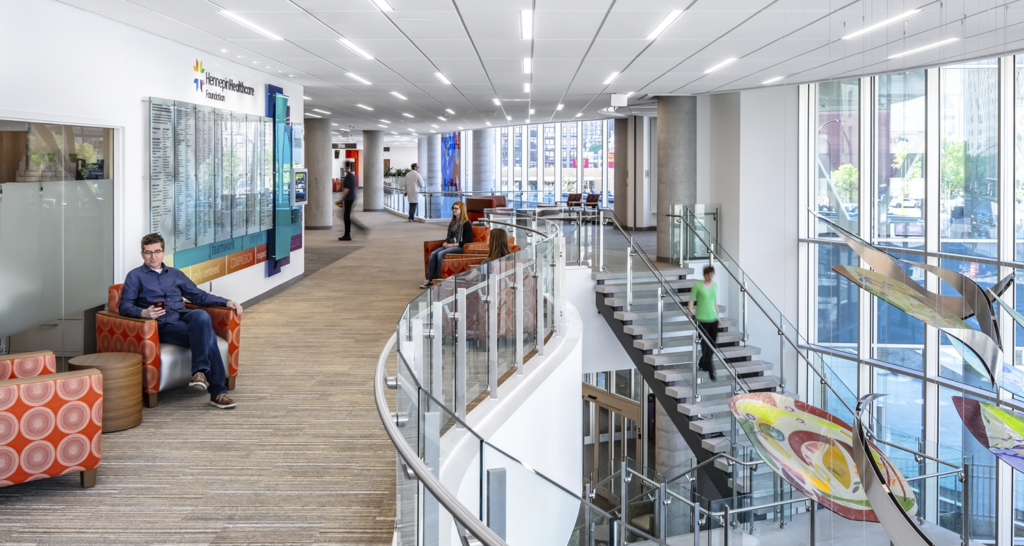Conversations around sustainable building practices can often focus on intangibles, or on the perceived moral implications of performance design, but this fails to take into account the various ways in which sustainable design also makes good business sense. Here are a few of the ways BWBR helps our clients examine the bottom-line impacts of sustainability within the context of their specific projects.
Business Continuity and Risk Management
There are a number of real (and increasing) risks that can disrupt and threaten the longevity of your business, including supply chain issues and severe weather events — many of which are persuasively linked to climate change. Part of safeguarding continued operations is BWBR’s scenario planning, which accounts for and mitigates these risks. How can you be prepared to face climate change/weather challenges that might come your way? The answer will depend on your geography, region, and other particular risk factors, but regardless, a good design should consider how best to mitigate the risks that your project will face in order to keep your business operational for the long haul.
Carbon taxes and increased financial risks are also encroaching more heavily on the U.S. market and proactive businesses should plan accordingly. For example, St. Louis recently implemented a Building Performance Energy Standard, with other U.S. cities surely to follow. Carbon taxes based in other countries that address the full supply chain are already impacting American businesses who are second or third-tier suppliers to the originating organizations. We are also seeing lenders take these concerns more seriously when deciding where to extend credit and evaluating environmental impact in their risk calculations. Change is coming, and smart money is on planning and preparation, rather than reacting (which will almost certainly be more disruptive and expensive).
Reduced Operational Costs
Another area where sustainable choices can make a real difference is in reducing operational costs. There are multiple options beyond “status quo” and “expensive but sustainable approach,” and you might be surprised at the variety of ways you could integrate more eco-friendly HVAC options, for example. As a trusted advisor, your design team can help you navigate those options and find the best fit for your specific needs. Our job is to look out for your best interest and make sure you understand all the alternatives so you can make an informed choice with both the short- and long-term benefits in mind.
Every build is different, but in many cases, a slightly increased upfront cost is more than repaid in operational savings when you account for actual maintenance spend (and energy savings) over the lifetime of the system. Plus, you can often realize additional savings from avoided or delayed equipment replacement. By taking the long view, and not limiting your analysis and decision-making solely to upfront cost, you have the opportunity to realize greater return on investment.
Recruiting, Retention, and Engagement
Losing employees costs real money (and both turnover and competition for talent are sky-high right now). Yet we know that sustainable practices can have a major impact on someone’s decision to accept a role or stay with your organization. An engaged workforce is also a more productive, profitable workforce and sustainability can play a significant role in building that engagement.
Data shows that 74% of employees say their job is more fulfilling when they are provided with opportunities to make a positive impact on social and environmental issues, and 70% would be more loyal to a company that helps them contribute to important issues. Therefore, sustainability efforts can contribute tangibly to a more engaged workforce. Engaged employees outperform their peers that are not engaged, and companies with high employee engagement are 21% more profitable. Additionally, consider that the average turnover in a given year is around 15% (likely much higher under the current economic conditions) but, by retaining some of that talent, you can realize the associated cost (and labor) savings of replacing staff.
Healthier Environments for Employees
Data shows that healthier building environments lead to a healthier workforce, which benefits your business through decreased employee sick time and higher levels of engagement. Recent peer-reviewed studies indicate that businesses with good employee wellbeing programs significantly outperform companies listed on the S&P 500 index.
Given that Americans spend approximately 90,000 hours of their lives at work, and considering current COVID-19 implications and the fact that approximately 8% of U.S. adults over the age of 18 have asthma, indoor air quality can have a significant impact on keeping employees healthy enough to work and on convincing them to return to work in the office environment at all. One study showed that every time the rate of outdoor air delivery is doubled in an office, worker performance improved by 1.7% for simulated office tasks. The benefits of higher ventilation alone are estimated to be between $6,500 and $7,500 per person per year. If a return to the office is in your plans, it’s of material importance that you consider how you are going to meaningfully support employee health, and by extension, productivity.








